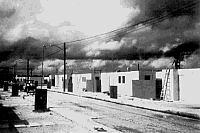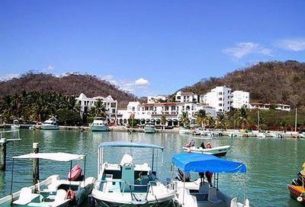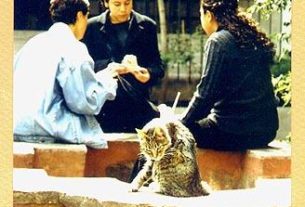When I tell my media friends that I am writing a book called “The Real Mexico”, they invariably act a bit dumbfounded and frequently ask how I can possibly know anything about the real Mexico if I’ve lived in Cancun since 1983, as if this resort city on the Mexican Caribbean were located in Brooklyn.
The media image of Mexico is either border crossings and disgusting industrial slave labor zones or colonial towns filled with people in cute costumes. Since most of Mexico was built in the past forty years or so, the reality is mostly based on cement block and steel girders in all varieties of taste and architectural distinction (or lack of it, mostly).
Mexico exports Volkswagens to Germany and oil drilling platforms to Ecuador. The world’s largest cement company is Mexican. They just love cement here. They could make a plane out of cement and it would fly. So Cancun is really a good representation of modern Mexico — except that it is a forbidden subject to New York media types.
This is what I call your basic wine and cheese cultural imperialism. Tastemakers in strategic power positions decide that it must have ferns and Tiffany lamps or it is not to be discussed any further.
The skewed American view of Cancun and Mexico was especially vivid in the 1996 Mexico issue of National Geographic, which was so distorted in general that we didn’t recognize Mexico.
They left out everything modern. You’d think it was all back in the days of Porfirio Díaz. Everyone thinks Cancun is an isolated example, but there are super-modern developments all over Mexico, even places like Mérida. I would guess that most of the urban areas were created in the last forty years. There are many exquisite modern neighborhoods — middle class and up — with discreet hand-hewn architecture, beautiful gardens, tree-lined streets dripping with flowers. We have lots of ugly concrete filing boxes, too, but when they do a story on Los Angeles do they only show pictures of Watts?
The double-page shot of the Hotel Zone was an example of what I call telling the truth in order to deceive. Taken apparently from a helicopter, it shows huge cement hotels filling the foreground, while a thin strip of beach dwindles trails off in the background.
No one experiences Cancun from this angle. They walk around in it. The telephoto lens grotesquely distorted the Punta Cancún section. This is the main commercial zone, with the largest concentration of shopping centers, public beach clubs, night spots, the convention center and its associated hotels and support services. It occupies about ten percent of the Hotel Zone’s total area. In the photograph, it looks as if it takes up most of Cancun.
Looking at this photograph, one could never know that the Cancun Hotel Zone is actually a 17 km. strip with water on both sides. The hotels are amphitheaters facing the sea, their backs to the lagoon and the highway. Unlike most resorts, the Hotel Zone is separated from the service areas. These are on the mainland in the city of Cancun.
You get out on that beach, which is hardly crowded even at the height of the season, and you could care less about the lack of architectural ambience. Cancun is a big industrial resort that mainly gives very tired urban casualties five days of fresh air and clean water for modest prices. We do have some super-luxury hotels that cater to jet-setters who want absolute anonymity, which they can’t get on the Mustique-type resorts because they are too small.

Because of the modern international architectural style that prevails everywhere here, many visitors assume that Cancun is some kind of foreign colony. This is not true. Foreign investment has played an important part, but Cancun was designed and built by Mexican architects and engineers. Mexicans are the majority investors in all the hotels. All the operating companies are Mexican corporations, even when they bear the names and logos of the foreign chains with which they are affiliated.
Many green-oriented Americans, Europeans and Mexicans feel that the modernization of Mexico is rape. Here in Cancun, almost everyone else sees it as good and useful progress. The jungle isn’t beautiful to people who have lived in it. It’s terrifying.
During 1999, eighteen workers clearing land for the new developments down the coast died from snake bites. Two years ago, a nine-foot crocodile dragged a dozing fisherman into the ocean at Punta Nizuc, the still mostly undeveloped extreme end of the Hotel Zone, and nearly tore his arm off while he successfully struggled to escape.
In Chetumal, the capital, there are men with missing noses and ears, eaten by a worm that lives in the chico zapote trees (great fruit — its sap is used to make chewing gum). People used to starve to death here. People have fantasies of living the peasant life with nature. Try it. It’s just hell on earth unless you have enough money to surround yourself with loyal workmen who keep the jungle at bay by constantly cutting it back.
Living with nature and gathering chicle vs. turning on the air conditioner and watching digital TV after a satisfying day approving credit card vouchers is a major cultural confrontation issue. There’s a lot of conflict with green types about this. Most Mexican people have been poor so long that they just can’t understand the fuss about nature and ecology and so on. They love cement houses. After we went through Hurricane Gilbert, we understood why.
There are really simple people here who refer to a cement house as “una casa de material” — a house made of material, because it’s made of stuff from a construction materials store, not palm thatch or tar paper. They call the bus “la ruta” — the route — because busses are labeled with a route number – “Ruta Cuatro” — Route Four. When we lived in Puerto Morelos, I was regularly driven to Cancun by a taxi driver who firmly assured me that there are snakes that suck the milk out of sleeping nursing mothers’ breasts.
Now these people have houses (mostly the cement equivalent of tarpaper shacks) and their kids go to computer school. So they see modernization and consumerism as salvation and they want more of it. They remind me a lot of the French after the Revolution. The French tried to erase the old map and divide the country into perfectly metrical squares — because the twists and turns of the old borders represented ancient wars and privileges. This attitude is what eventually lead to the Bauhaus and the International style and Courbusier. The past was dirty and ugly and evil. They wanted to clean it up.
Mexican culture is syncretic. It absorbs mutually contradictory themes, happily ignoring the worst fits. The tropical jungle isn’t uniform like northern forests, which are mostly composed of a few dominant species. The jungle is a tangled mat of many different kinds of trees and vegetation. There are no great stands of mahagony. The trees have to be sought out and logged one by one. In the same way, Guadalupe, the Indian Mary, is Ixchel, the goddess of love, and her shrine, like all Mexican Catholic shrines, is located on a site that was sacred before the Aztecs arrived, much less the Spaniards.
To the Mexican, Cancun fits just fine in the real Mexico. They see Mexico as it is, not the way it looks in travel magazines. Cancun isn’t plastic. It’s cement. but from a sociological perspective it also happens to be one of the most interesting places I’ve ever lived. Sometimes I think it’s my punishment for being a liberal. This is where the liberal dream comes true — that government, labor and business can work together to eliminate starvation, disease, homelessness and unemployment (among other evils) if not stupidity, neurosis and evil.
That may not have the media appeal of crumbling adobe houses and abandoned mines, but it is the real Mexico, like or not. Instead of sneering, I think American media types ought to study Cancun and see what makes it tick. You never know, they might learn something about making things work.
This post was formerly illustrated with photographs by Faera Siegel © 2000.
Published or Updated on: December 1, 2000



